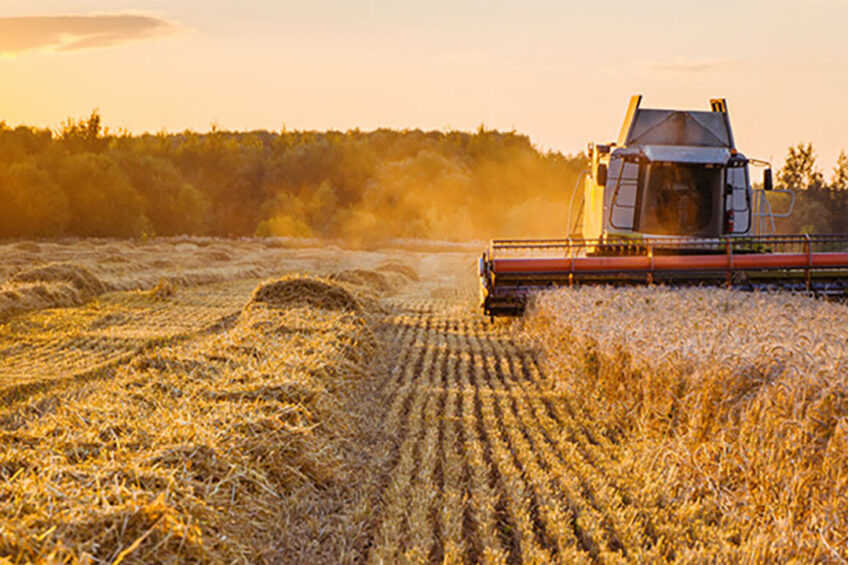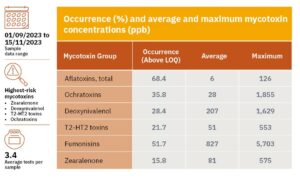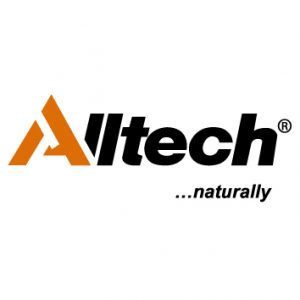Late season rains create mycotoxin challenges in Europe

The Alltech European Harvest Analysis, a decade-long initiative, is a comprehensive step in understanding the complexities of new crop quality and mycotoxin prevalence. The programme captures trends and enables robust data comparisons across years and regions. This analysis plays a pivotal role in empowering feed and livestock producers with the knowledge they need to make informed decisions.
Alongside the independently accredited Alltech 37+ laboratory at Dunboyne that can detect up to 54 individual mycotoxins, collaborators like SGS, one of the world’s leading testing and certification companies, enable us to capture the most robust set of new crop mycotoxin data across 20 countries in Europe.
As part of the 2023 European Harvest Analysis, over 1,100 grain and forage samples have been assessed. While Europe enjoyed a reprieve this growing season from the extreme drought conditions of the past 2–3 years, rains that fell close to harvest in northern and western Europe caused delays that created ideal conditions for mould and mycotoxin development. These challenging conditions have resulted in an overall higher-risk mycotoxin year in Europe in 2023, with 4.4 being the average number of mycotoxins detected in each sample.
The mycotoxin challenge across specific ingredients
To deliver the most accurate representation of mycotoxin risk, Alltech places a large emphasis on testing the most prominent grains and forages that are used in Europe, but grains that may be exported to other regions are tested also. In Asia, for example, this can help to inform purchasing decisions related to specific commodities.
Now, let’s look at some of these ingredients in more detail.
Corn
Aflatoxin challenges arising from drought-stricken corn have dominated the mycotoxin picture in Europe in recent years. Growers were thankful not to suffer the same fate in 2023. However, it was still not a perfect growing season, and with over 700 new-crop corn samples analysed this year, we can gain a good insight into the mycotoxin dynamics in this ingredient.
Based on most samples coming from central and southern Europe, aflatoxins were detected in almost 70% of samples (Figure 1), with average levels of 6 ppb. However, most of the risk in corn is coming from Fusarium mycotoxins such as zearalenone, deoxynivalenol and T2-HT2 toxins. Ochratoxin was more prevalent this year than in 2022, with average levels detected of 28 ppb. The overall corn risk is deemed low to moderate when Alltech’s REQ metric is applied.
Figure 1- The mycotoxin risk patterns in European new crop corn, analysed by SGS.

Wheat and barley
New crop samples of wheat and barley typically originated in countries across northern and western Europe. Conditions in this region deteriorated badly around mid-June, and from then onwards, unsettled weather caused havoc with harvest dates, resulting in crops standing much longer in the field than they usually would. The combination of wet and humid conditions with a delayed harvest resulted in the ideal conditions for Fusarium moulds to thrive.
This has directly manifested in elevated levels of mycotoxins in these small grains, with barley posing particular problems. Although specific reasons are unidentified, barley is much higher risk than wheat, and contains almost double the number of mycotoxins per sample.
Penicillium mycotoxins are not something we would typically associate with small grains at harvest time, but they have been more commonly detected this year, possibly due to the extremely challenging field conditions. Emerging mycotoxins are the most common groups detected across both ingredients, but the most risk is coming from type B trichothecenes. In barley, as is displayed in Figure 1, average levels of this group are at 922 ppb, with an extraordinary maximum of almost 29,000 ppb detected in one Finnish sample. Using REQ and Alltech PROTECT to assess animal impacts, the consumption of barley at such high-risk levels could reduce average daily gain by up to 63 grams in grow-finish pigs (Table 1).
Forages
Although the Penicillium challenge has been the dominant talking point with forages over the past few years, it is worth comparing the mycotoxin profiles and primary risk drivers in corn silage and grass silage.
As with most ingredients, emerging mycotoxins are most prominent here. However, in corn silage, type B trichothecenes are present in over 95% of samples, with average levels of 1,561 ppb, amplifying the risk. In comparison, grass silage is facing the greatest risk from Penicillium mycotoxins, with average levels of 338 ppb and an occurrence above 62%. Dr Radka Borutova, Alltech’s European technical specialist, has noted that when both of these ingredients are included in a total mixed ration (TMR) diet, this can create an even greater cocktail of risk for dairy or beef animals.
The late harvest in northern and western Europe amplified the challenge in straw that was lying on the ground for a prolonged length of time. The 60 straw samples submitted to the lab this year were, as in recent years, heavily contaminated with emerging mycotoxins and type B trichothecenes. Average levels of type B trichothecenes were almost 1,500 ppb. This is something for livestock producers to be aware of wherever straw is either being used as a bedding or feed material.
Managing the ongoing dynamic risk
Mycotoxins are a truly dynamic issue, and although testing immediately post-harvest gives a great overview of regional contamination patterns, what happens before the animal receives the feed — including storage conditions post-harvest and feeding practices on-farm — can have a large influence on shaping what the animal will actually be ingesting in terms of mycotoxins. To best manage this ongoing challenge, consider a routine testing program that can uncover the specific risks to your business. With this information, you can make an informed choice on what mitigation strategies are necessary to support the health and performance of your animals.
Sign up to receive further information
To access the complete Alltech 2023 European Harvest Analysis report, as well as a series of videos that provide further species-specific insights, please visit our Harvest Analysis webpage.











